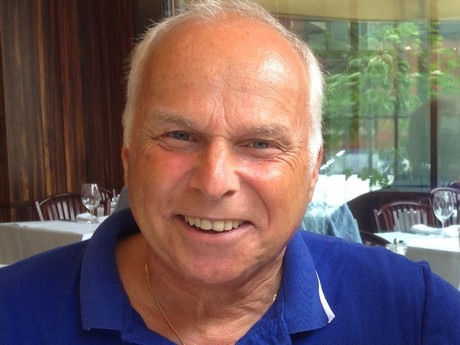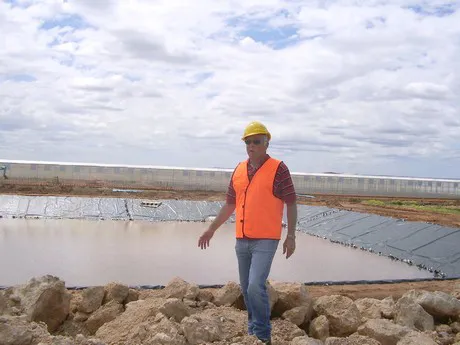He started his career in the world of cars, but soon found himself hooked on horticultural techniques. Carel Zwinkels recently waved goodbye to AAB nl, but it can’t be called a real farewell. “I have almost 40 years of horticultural techniques on the counter. I will keep on following the developments in horticulture.”

Carel, being the son of a tomato grower, started in the service department at car importer Louwman & Parqui back in 1976. After a year, a service department for Suzuki and Ducati motorbikes was set up by him, among others. He continued his career at Suzuki. When the first Alto’s were put on the Dutch market, there was no more challenge for Carel. The trade journals he was reading at home interested him a lot more.
At the start of the ’80s, the Dutch horticulture made a massive shift from cultivating on open fields to cultivating in substrates. With a great interest in tech, he followed the development closely. A Revaho commercial caught his attention, which is how Carel ended up in the horticulture industry back in April of 1981. “At Revaho, I did what I couldn’t do in the car industry, which contributed to the design of technical installations. Due to the shift to substrates, drippers where developed left and right.”
Dripper water poured out
There were plenty of challenges. “A pepper greenhouse in the Dutch, Den Hoorn wanted to make the switch to substrates, but because the greenhouse was built on a dike, the ground was slanted. Because of that, the water in the drippers poured out. We asked Netafim if they could also make the drippers sealable. Now, that type of dripper is known as the chameleon dripper. “If only I had the patent for it”, he says jokingly.
Advice for Indonesia
At the start of the ’80s, horticulture was already international. “In 1981, a delegation from Indonesia came over. They wanted to start a horticulture company and came here to enquire about it. They had set their sights for NFT (Nutrient Film Technique), but we explained to them that drip irrigation was much safer. “Buy a piece of land near a university so you can educate people and set up a simple greenhouse made off bamboo or plastic (Mohican greenhouse), that you can ventilate well. Put the seeds in bags of sand or coconut and make sure that it doesn’t become wet in the rain. And yes, I went to visit, it all looked very decent. They had analog measuring equipment because there were regular power outages. A Belgium grower went there to set up the cultivation, and when the first tomatoes were being harvested, I heard that they even wanted to export the tomatoes to Singapore.”
Start to work at AAB
After an outing at a greenhouse building company and in the screens sector, he spent eight years working with water techniques at Royal Brinkman. In April 2000, Carel started working at Agro Advice Buro, now known as AAB. Water techniques remained his specialty, but he also learned about greenhouses, screens, heating, and all other aspects of a greenhouse in practice. “As a grower's son, you got the curiosity of wanting to find out how everything works flowing through your veins. I entered the company as the twelfth employee. Aab was still a small company back then. This makes the company very dynamic, and you learned a lot from your colleagues.”
Great projects
Carel was appointed to supervise the construction of new development projects. “The drive to expand could not be filled in the Dutch Westland. This led to Agriport regions in Middenmeer, Someren, and Luttelgeest. I had the chance to supervise some great projects. Tomatoes and peppers of up to 44 hectares.” The small projects are just as interesting to Carel.
“For instance, the roughly 500 square meters at KeyGene in Wageningen. Ten departments filled with high-quality technics, like double screens, lighting, and with drip irrigation and ebb and flow systems. We supervised the construction of these projects by “Grass to Glass”. After discussing with the client, you set up a plant date about two years in advance. It still gives me a rush when, on that date, the plants get placed into the greenhouse.”
 Building inspection in Australia.
Building inspection in Australia.
Major contract
The name change from Agro Advice Buro to AAB nl was made in 2015. In that same year, a millions contract for the procurement of Serres Toundra in Canadas was signed under the watchful eyes of King Willem Alexander and Queen Máxima. “Agro Advice Buro didn’t sound very good in English. By the time you explained how to spell it, you already finished up your calling credit," he jokes. The project in Félicien consists of 4 blocks of 8.5 hectares each. In 2016, production started for the first block, and at the moment, the foundation for phase 2 is being placed. “In Quebec, they are happy with the local cucumber production. There is only 80 hectares worth of vegetable cultivation over there, even though 8.5 million people are living in the Quebec region.”
There are more projects abroad he looks back at fondly. D’Vine Ripe, for instance, one of the biggest tomato nurseries in Australia. “During that time, it was 8 hectares, and in 2010, 9 hectares of paths and fan greenhouse were added. By now, the nursery has grown to be 45 hectares with now two semi-closed greenhouses of 8.5 hectares each. Semi-closed greenhouses have replaced the path and the fan greenhouses in order to keep the CO2 leveled better. Cooling with the windows closed, that saves a lot.”
Having good people is keeping good people
“Our advice services have changed in the past twenty years. In the crisis years of 2008 and 2010, AAB developed a broad scale of services. The energy advice is very important these days, just think of the development of geothermic energy. You can set up any project you like, but it should still be able to stand after fifteen years. A grower needs to keep on developing in order to stay afloat in this market”
The advice also includes topics such as labor. “A global problem. Although there are all sorts of developments in the field of robotization and automating work, the tech is not quite there yet. Growers across the globe still need hands to do the work, which are getting harder to come by these days, which is a real problem. In the Dutch greenhouses, besides Polish workers, more and more Bulgarian and Romanian workers join in. Australia gets its laborers from Cambodia and Vietnam, and in Canada, a lot of people from Guatemala are working. Having good people is keeping good people, so growers need to do whatever they can to provide their people with good housing. Serres Toundra recently bought a vicarage where their employees can live in. The people are grateful for it.”
Holiday feeling
After a well-attended farewell reception on the 15th of November, Carel went on a journey to South-Africa. “I feel like I am on a long holiday. I will mainly focus on volunteer work for football and the church now, and I will spend more time gardening and cycling.” However, that doesn’t mean that he won't show his face at conventions anymore. “With a happy heart, I say goodbye to almost 40 years of horticulture technics. If anyone needs my help, don’t be afraid to ask.”
--
This is the ninth part of a series 'Andere Tuinbouwtijden' in which a group of 'seasoned workers in the field' look back at times long gone. And in which we look at what their work meant to the current horticultural industry.
Part 1: Piet Bom - Will your next greenhouse be made of Fiberglass?
Part 2: Henry van der Lans - We slept in the same little hotel...
Part 3: Rob Grootscholten – 42 years of greenhouse construction...
Part 4: Peter Stuyt – As a Dutch American, I like to combine...
Part 5: Leo Alsemgeest - Bit by bit a step back
Part 6: Harry Dullemans – Never say you are not there...
Part 7: Kees de Groot - We must make something different than...
Part 8: Leo Alleblas – The urge for adventure is in our blood
